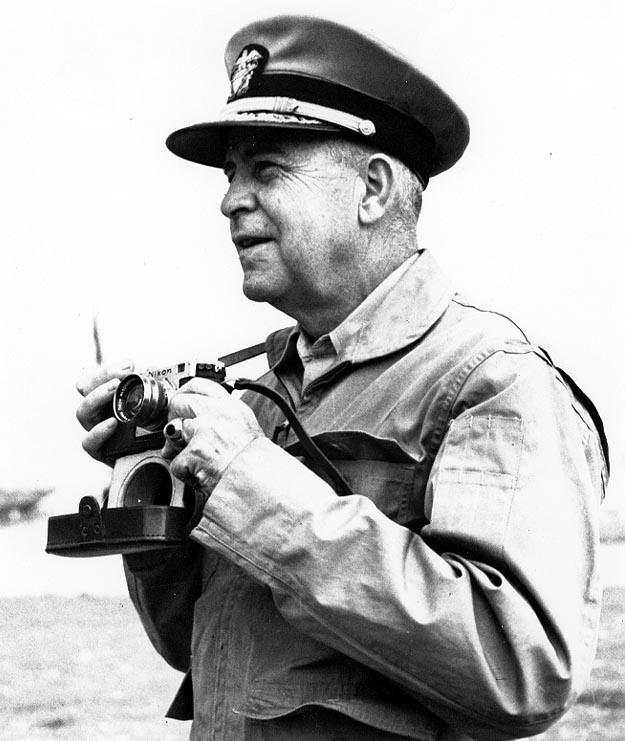Years of service 1916-1954 | Rank Vice Admiral Name C. Joy | |
 | ||
Died June 6, 1956(1956-06-06) (aged 61)San Diego, California Allegiance United States of America | ||
Admiral C Turner Joy meets Admiral Doyle and Lieutenant Duncan Joy on his arrival...HD Stock Footage
Vice Admiral Charles Turner Joy (17 February 1895 – 6 June 1956) was an admiral of the United States Navy during World War II and the Korean War. During the last years of his career, he served as Superintendent of the Naval Academy. The destroyer USS Turner Joy (DD-951) was named for him.
Contents
- Admiral C Turner Joy meets Admiral Doyle and Lieutenant Duncan Joy on his arrivalHD Stock Footage
- USS C Turner Joy DD 951 The Untold Story
- Early life and career through World War I
- Interwar years
- World War II
- Post World War II and Korean War
- Last years and legacy
- Decorations
- References

USS C Turner Joy (DD-951) The Untold Story
Early life and career, through World War I
C. Turner Joy was born in St. Louis, Missouri, on 17 February 1895. Commissioned as an Ensign in the Navy upon graduation from the U.S. Naval Academy in 1916, he served in the battleship Pennsylvania (BB-38) for more than four years, including the period of the United States' participation in World War I.
Interwar years
In 1923, after receiving a graduate education in engineering, he began two years as Aide and Flag Lieutenant to Commander, Yangtze Patrol. This was followed by a tour as Executive Officer of the Asiatic Fleet destroyer Pope (DD-225), an assignment with the Bureau of Ordnance, sea duty in the battleship California (BB-44), and service at the Naval Mine Depot at Yorktown, Virginia.
In the mid-1930s, Lieutenant Commander Joy was Commanding Officer of the destroyer Litchfield (DD-336) and was on the staff of Commander Destroyers, Battle Force.
Between 1937 and 1940, Commander Joy was an instructor at the Naval Academy. He then became Executive Officer of the heavy cruiser Indianapolis (CA-35).
World War II
In 1941 he was Operations Officer for Commander Scouting Force, Pacific Fleet and, for several months after the United States entered World War II in December of that year, helped plan and execute combat operations against Japan.
Captain Joy commanded the heavy cruiser Louisville (CA-28) from September 1942 until June 1943, during which time he was active in the Aleutians and South Pacific war theatres.
After an important war plans tour in Washington, D.C., Rear Admiral Joy became commander of a cruiser division, leading it through nearly a year and a half of intense combat service against the Japanese.
Post-World War II and Korean War
Commanding an amphibious group when Japan capitulated in August 1945, Joy was soon assigned to duty in China. He was in charge of the Naval Proving Ground at Dahlgren, Virginia, in 1946–49 and was then sent back to the Western Pacific to become Commander Naval Forces, Far East. Vice Admiral Joy held that position until mid-1952, directing much of the Navy's effort during the first two years of the Korean War. From July 1951 until May 1952 he was also the senior United Nations Delegate to the Korean Armistice talks. His experience in this role let him to write a book, How Communists Negotiate. In the book he detailed a number of different tactics that were used during the talks to delay, frustrate, and create useful propaganda for the North Koreans. His observations included the fact that the North Koreans, being generally shorter, would set shorter chairs for the UN delegates to appear equal in height.
His final assignment was as Superintendent of the U.S. Naval Academy.
Last years and legacy
Retired in July 1954, Admiral Joy subsequently made his home in La Jolla, California. He died at the U.S. Naval Hospital in San Diego, California on 6 June 1956. He is interred at the United States Naval Academy Cemetery.
The destroyer USS Turner Joy (DD-951), 1959–1991, was named in honor of Admiral Joy. Turner Joy Road at the Naval Academy is also named in his honor.
Decorations
Vice Admiral Charles Turner Joy´s ribbon bar:
